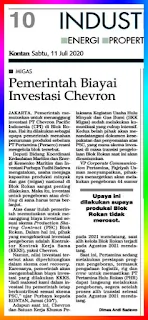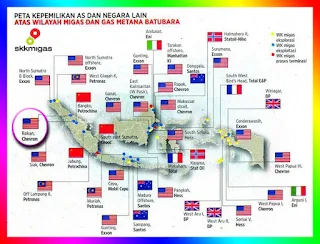PT Pertamina (Persero) is committed to increasing oil production from the Rokan Block to return to 200 thousand barrels per day (BPD) after its management switches to the company in August 2021. On the other hand, the Regional Government hopes to get dividends from the oil and gas block starting in 2022.
PT Pertamina Hulu Energi (PHE) President Director Budiman Parhusip said that after the management of the Rokan Block switched to Pertamina starting on August 8, 2021, he would immediately continue drilling wells in the oil and gas block. Continuity of drilling activities is needed to increase oil production from the oil and gas block in Riau Province.
"So that from [production] 170-180 thousand BPD, we will try to increase by drilling a lot of wells so that it can reach 190-200 thousand BPD in the future, maybe even higher," he said.
He said well drilling was one of the strategies to increase Rokan Block oil production. In addition, another strategy is that it will try to apply some new technologies such as 3D seismic technology, see the possibility of doing advanced oil recovery (enhanced oil recovery / EOR) with chemicals, and other technologies.
Budiman added that his efforts to increase oil production in the Rokan Block highly depend on the implementation of the management transition period from PT Chevron Pacific Indonesia. At present, it is being discussed how to keep Chevron from drilling new wells in late 2020 and in 2021 to curb the decline in Rokan Block production.
"We hope that production can be maintained in the range of 170-180 thousand BPD when Pertamina takes over," he said.
This includes the preparation of a work program in the Rokan Block for next year. Thus, Pertamina has got a clear picture of what activities must be carried out once the management of the Rokan Block by Chevron ends.
"So, in August 2021, we were clear about what would be done, continue what the previous operator had done, even improved," said Budiman.
Expert Advisor to the Special Task Force for Upstream Oil and Gas Business Activities (SKK Migas) Satya W Yudha revealed, the transition period for the management of the Rokan Block must take place well so that production does not go down. So far, there have been plans to drill wells by Chevron in 2020 and early 2021 to keep the production of the Rokan Block from falling dramatically. Although this matter needs further discussion with Chevron and Pertamina.
As per the proposal, Chevron will operate 2 rigs to drill 11 wells in the Rokan Block in November-December this year. Furthermore, in January next year, Chevron will run 5 rigs to drill 96 wells. Estimated costs needed for drilling are US $ 11 million in 2020 and US $ 115 million next year. In 2020, he acknowledged that the additional oil production from drilling activities was very small, namely only 500 BPD.
"We hope that if the commitment is carried out properly by Chevron, there will still be an additional 5,000 BPD when it is submitted to Pertamina in 2021. So the production will be 175 thousand BPD," Satya said.
On the other hand, according to the contract, Pertamina has a definite work commitment (KKP) for the first five years in the Rokan Block worth the US $ 500 million or around Rp 7.2 trillion. Some of the activities to be funded by the CTF include an EOR study of US $ 4 million, drilling of 11 exploration wells of the US $ 69.8 million, drilling of five Telisa wells of the US $ 18.1 million, stage-1 CEOR 7 pattern of US $ 247 million, and stage-1 steam flood Kulin or Rantau Bais US $ 88.6 million.
Regional Participation
Meanwhile, Deputy Governor of Riau Edy Natar Nasution revealed, the region is entitled to a Participating Interest (PI) of 10% in the Rokan Block. The right to this PI is automatically owned by the regional government once the Chevron contract in the Rokan Block ends on August 8, 2021.
Once the management switches to Pertamina, SKK Migas will write to the Governor of Riau to ask for his interest in the PI 10%. Once approved by the Minister of Energy and Mineral Resources (ESDM), his party will begin the process of taking the 10% PI and receive a share of the revenue.
"We hope that in 2022, the Riau Province and related regency governments can already receive dividends from the 10% PI," said Edy.
However, he admitted, his party had yet to establish a Regionally-Owned Enterprise (BUMD) that would manage the Interest Participation of that part of the area. At present, his party is still conducting a selection of its BUMDs to determine who is managing the PI 10%.
"The governor who determines [BUMD manager] after the selection is complete," he added.
In accordance with the Minister of Energy and Mineral Resources Regulation No. 37 of 2016, oil and gas contractors are required to transfer management rights to local governments by 10% by offering it to BUMD. The offer was made since the approval of the first field development plan.
Each BUMD may only be given PI management for one work area. The 10% PI offer to BUMD is carried out through a cooperation scheme with the contractor. The cooperation scheme is carried out by means of advance financing by the contractor.
In addition, Edy also hopes that there will be opportunities for local entrepreneurs and the people of Riau to be involved in the implementation of the project once the Rokan Block is managed by Pertamina. The reason is, as soon as oil prices fall due to the Covid-19 pandemic, the regional budget (APBD) of its region is also affected. This is because about 65-80% of the APBD still relies on oil and gas revenue-sharing funds.
As of the end of March, Rokan Block's oil production was far higher than the target of the 170,763 bpd State Budget (APBN), which reached 182,350 bpd. Until the end of the year, Rokan Block's oil production is projected at 172,434 bpd.
Investor Daily, Page-10, Wednesday, July 22, 2020





















































